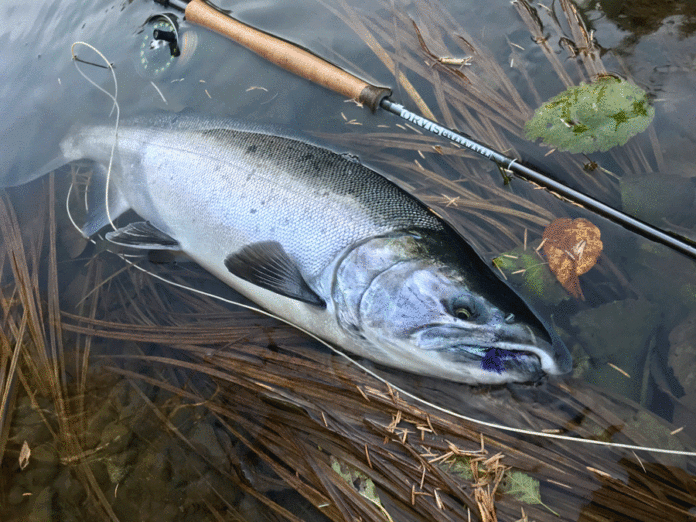Article and photos by: John R. McMillan
Do you ever wonder why fly anglers fish for steelhead in
riffles? Or why we fish pools and other slow-water habitats for coho salmon?
Most anglers would just say, “because that’s where they are,
duh.”
Not man fly fishers spend time rummaging through biology
papers to better understand the fish. But perhaps we should: After all, becoming
a better angler is as much about improving knowledge about the fish as it is
about improving technique and using the right equipment.

Anglers are a keen bunch and many are aware that different species of salmon and trout have slightly different preferences in habitat. For example, steelhead prefer riffles, runs, and other habitats with faster water and larger gravel and cobble. On the other hand, coho salmon have a stronger affinity for pools and slow water habitats, especially those with large wood for cover. And unlike steelhead, cohos don’t mind sandy bottoms or pebbles, because substrate size is not as important as the speed of the water.
I’m a fishery scientist, in addition to an angler, so I really enjoy trying to use biological knowledge about species to better understand the fish and if possible, improve my angling efficiency.

So what’s the biological mechanism underpinning the
differences in habitat use between steelhead and coho salmon? It all starts
with body shape. Out of the egg, both species look fairly similar, but within six
months there are noticeable differences. Juvenile cohos have taller bodies –
from belly to the back – and very large anal and dorsal fins. Juvenile steelhead are more fusiform, spindly
and tapered at both ends, with smaller
dorsal and anal fins, but relatively larger pectoral fins.
These differences are key. The less fusiform body of the
coho makes it more difficult to hold in faster water. They need to expend more
energy to do so than the more streamlined shaped steelhead. However, there is
no such cost to holding in slow-water habitats, such as pools, and in those
instances, their taller bodies and larger anal and dorsal fins allow them to
quickly maneuver side-to-side in search of food. They are supremely adapted to feeding in pools
with lots of competitors. Steelhead are not as good at actively feeding as the
coho salmon. Instead, their body is best suited to holding in fast water, where
they hide behind rocks and wait for the food to be delivered to them. One is a
quick-turning dart, the other a submarine.

In this context, juvenile cohos use pools because their body
is better adapted to feeding in those habitats, while steelhead are more
adapted to feeding in riffles and runs.
It also means that as adults, each species is relying on habitats that
they used when they were juveniles, even though they are not feeding. It’s hard
for a leopard to change its spots.
Although body shape is the primary determinant, there are
other biological factors at play. Coho salmon tend to aggregate into schools
more frequently than steelhead, with a clear exception being summer steelhead,
which also often school and stage in pools. This is also particularly true when
they are juveniles. At that life stage, coho salmon are typically found in
large schools, while juvenile steelhead are not.

Ultimately then, the habitat steelhead and coho salmon use
the most as adults is the same
habitat they relied on as juveniles. The reasons include body shape, feeding
capability, and social behaviors. And that is why understanding their biology
is so important to anglers: because it provides a mechanism for explaining how
fish have adapted to certain stream habitats, and in turn, why we fish
different types of habitat for different species.
A lifelong steelhead angler, John McMillan has spent hundreds of days snorkeling steelhead rivers, observing the fish in their native habitat, and at one time he was fishing about 345 days a year. John has worked for the US Forest Service, the Hoh Indian Tribe, the Wild Salmon Center, and recently for NOAA on the Elwha Dam removal project.
Credit: Source link































